IMAT5205: Analysis and Design of the Wide World Tour Management System
VerifiedAdded on 2023/04/20
|10
|2099
|383
Report
AI Summary
This report presents a comprehensive system analysis and design for the Wide World Tour Management System (WWTMS). It begins with a use case realization for the 'Record New Tour' use case, followed by detailed analysis class diagrams, communication diagrams, and sequence diagrams to illustrate system interactions and data flow. The report also includes an evaluation of CASE tools, emphasizing their role in software and system development, cost reduction, and adherence to business requirements. The Enterprise Architecture CASE tool is highlighted for its use in creating diagrams and visualizing system functionalities. The report concludes with a bibliography of relevant sources.
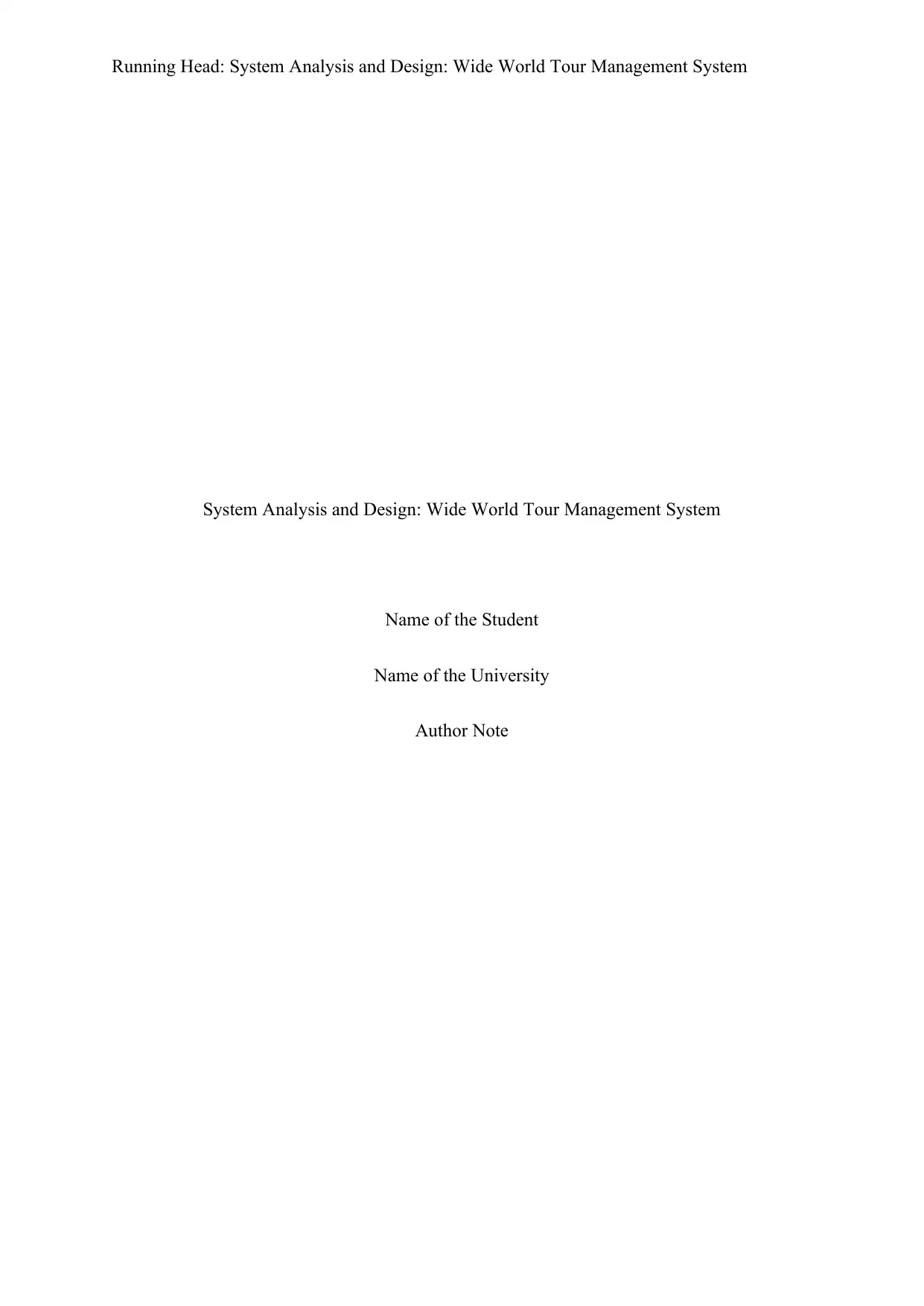
Running Head: System Analysis and Design: Wide World Tour Management System
System Analysis and Design: Wide World Tour Management System
Name of the Student
Name of the University
Author Note
System Analysis and Design: Wide World Tour Management System
Name of the Student
Name of the University
Author Note
Paraphrase This Document
Need a fresh take? Get an instant paraphrase of this document with our AI Paraphraser
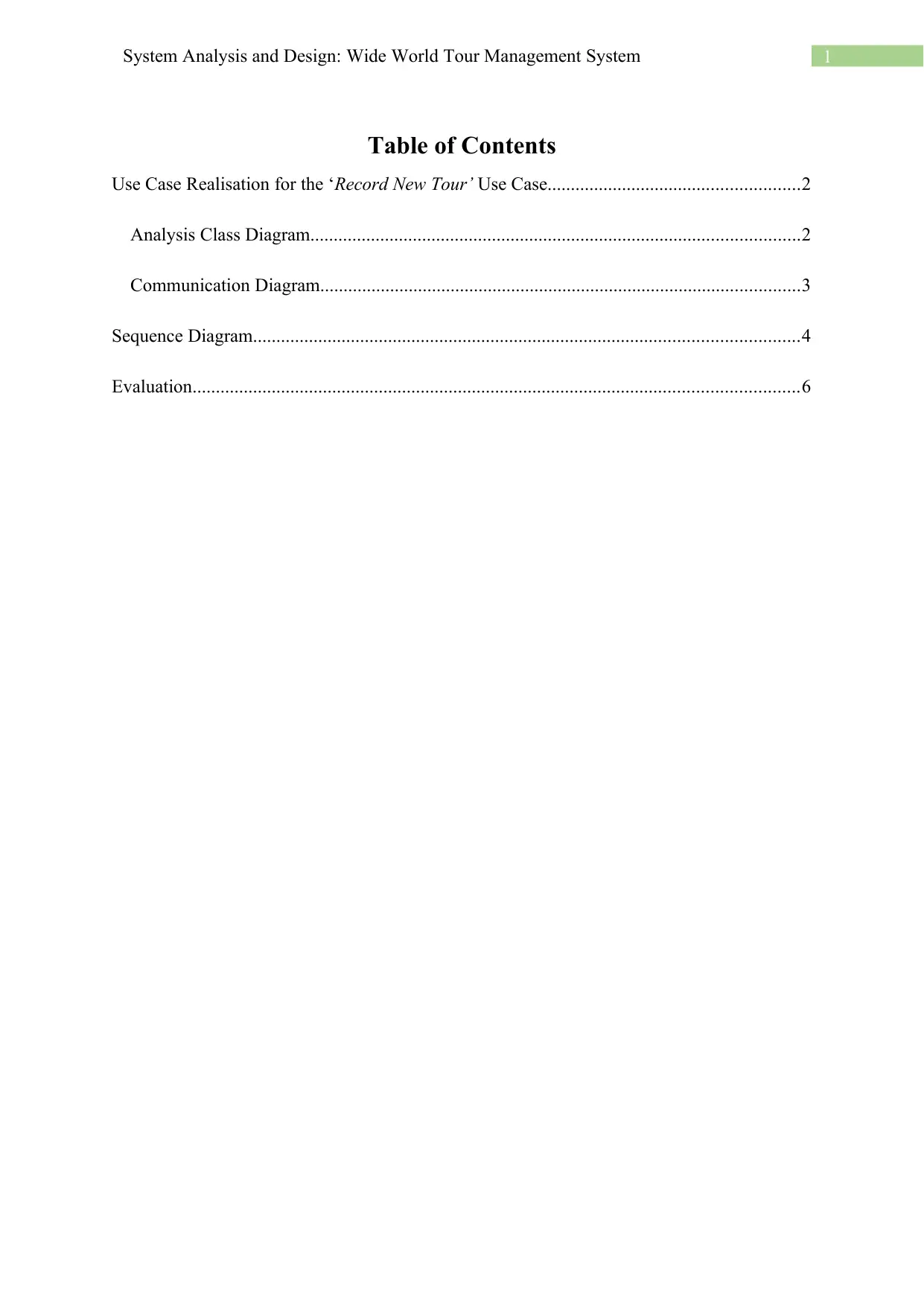
1System Analysis and Design: Wide World Tour Management System
Table of Contents
Use Case Realisation for the ‘Record New Tour’ Use Case......................................................2
Analysis Class Diagram.........................................................................................................2
Communication Diagram.......................................................................................................3
Sequence Diagram.....................................................................................................................4
Evaluation..................................................................................................................................6
Table of Contents
Use Case Realisation for the ‘Record New Tour’ Use Case......................................................2
Analysis Class Diagram.........................................................................................................2
Communication Diagram.......................................................................................................3
Sequence Diagram.....................................................................................................................4
Evaluation..................................................................................................................................6
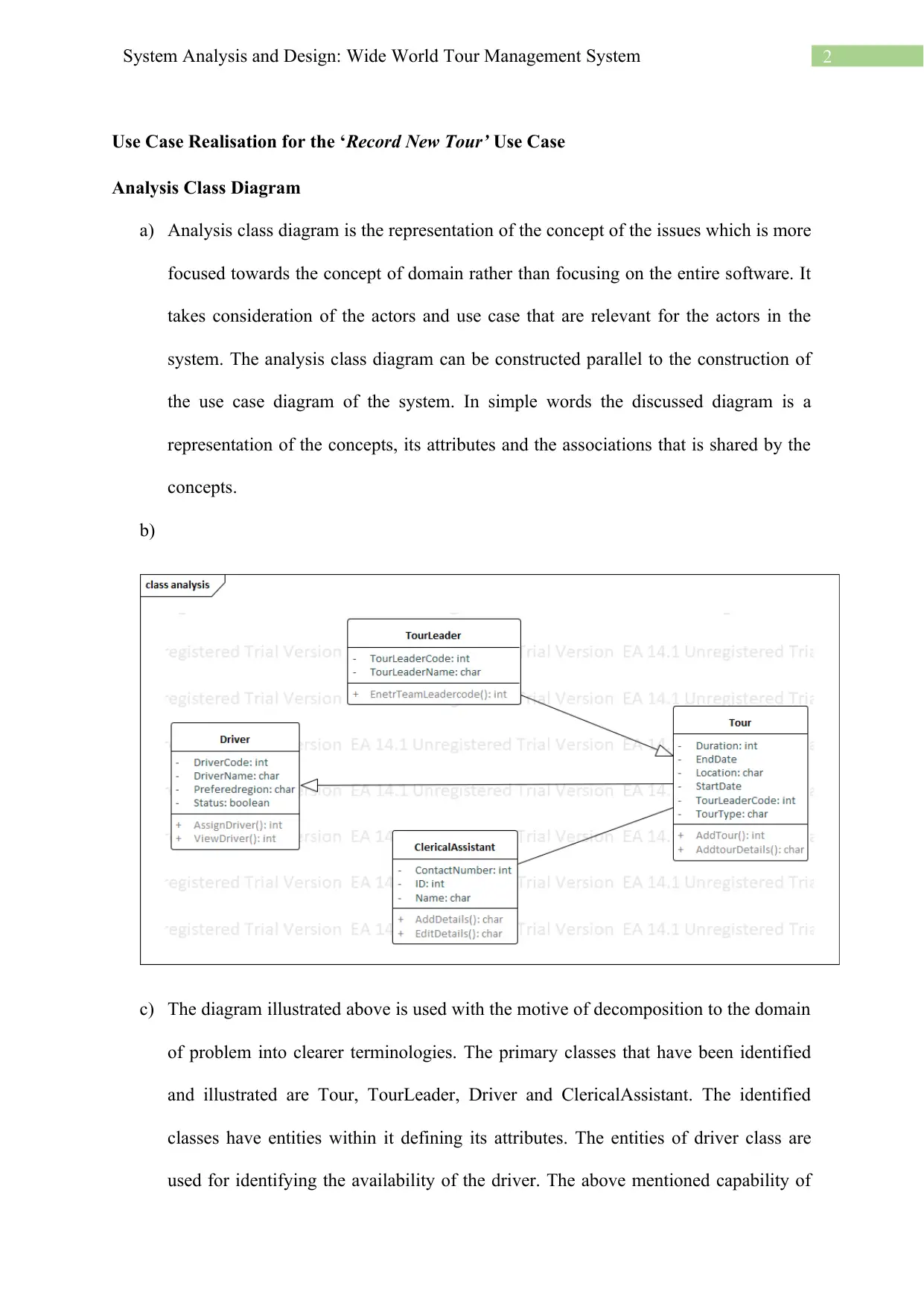
2System Analysis and Design: Wide World Tour Management System
Use Case Realisation for the ‘Record New Tour’ Use Case
Analysis Class Diagram
a) Analysis class diagram is the representation of the concept of the issues which is more
focused towards the concept of domain rather than focusing on the entire software. It
takes consideration of the actors and use case that are relevant for the actors in the
system. The analysis class diagram can be constructed parallel to the construction of
the use case diagram of the system. In simple words the discussed diagram is a
representation of the concepts, its attributes and the associations that is shared by the
concepts.
b)
c) The diagram illustrated above is used with the motive of decomposition to the domain
of problem into clearer terminologies. The primary classes that have been identified
and illustrated are Tour, TourLeader, Driver and ClericalAssistant. The identified
classes have entities within it defining its attributes. The entities of driver class are
used for identifying the availability of the driver. The above mentioned capability of
Use Case Realisation for the ‘Record New Tour’ Use Case
Analysis Class Diagram
a) Analysis class diagram is the representation of the concept of the issues which is more
focused towards the concept of domain rather than focusing on the entire software. It
takes consideration of the actors and use case that are relevant for the actors in the
system. The analysis class diagram can be constructed parallel to the construction of
the use case diagram of the system. In simple words the discussed diagram is a
representation of the concepts, its attributes and the associations that is shared by the
concepts.
b)
c) The diagram illustrated above is used with the motive of decomposition to the domain
of problem into clearer terminologies. The primary classes that have been identified
and illustrated are Tour, TourLeader, Driver and ClericalAssistant. The identified
classes have entities within it defining its attributes. The entities of driver class are
used for identifying the availability of the driver. The above mentioned capability of
⊘ This is a preview!⊘
Do you want full access?
Subscribe today to unlock all pages.

Trusted by 1+ million students worldwide
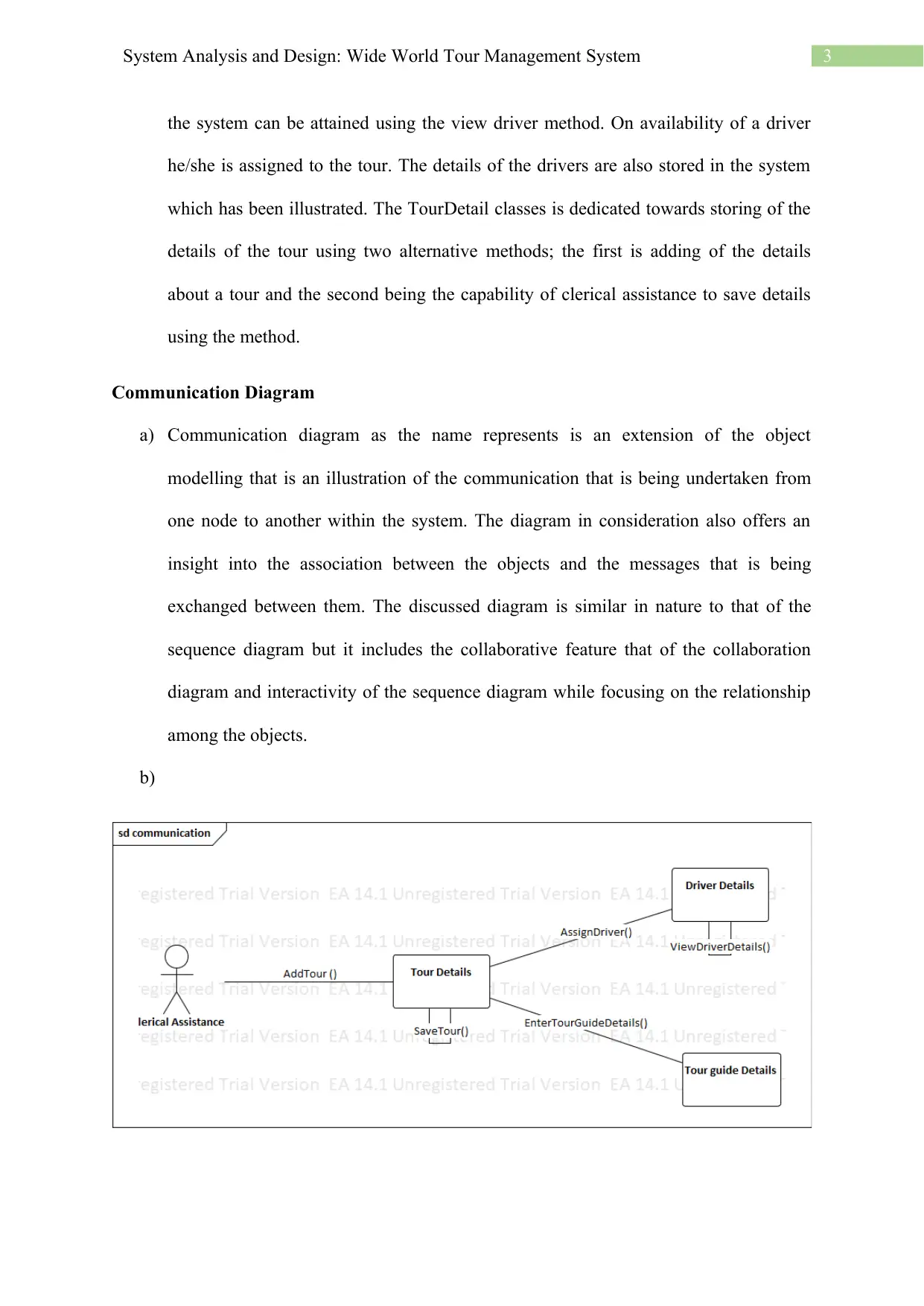
3System Analysis and Design: Wide World Tour Management System
the system can be attained using the view driver method. On availability of a driver
he/she is assigned to the tour. The details of the drivers are also stored in the system
which has been illustrated. The TourDetail classes is dedicated towards storing of the
details of the tour using two alternative methods; the first is adding of the details
about a tour and the second being the capability of clerical assistance to save details
using the method.
Communication Diagram
a) Communication diagram as the name represents is an extension of the object
modelling that is an illustration of the communication that is being undertaken from
one node to another within the system. The diagram in consideration also offers an
insight into the association between the objects and the messages that is being
exchanged between them. The discussed diagram is similar in nature to that of the
sequence diagram but it includes the collaborative feature that of the collaboration
diagram and interactivity of the sequence diagram while focusing on the relationship
among the objects.
b)
the system can be attained using the view driver method. On availability of a driver
he/she is assigned to the tour. The details of the drivers are also stored in the system
which has been illustrated. The TourDetail classes is dedicated towards storing of the
details of the tour using two alternative methods; the first is adding of the details
about a tour and the second being the capability of clerical assistance to save details
using the method.
Communication Diagram
a) Communication diagram as the name represents is an extension of the object
modelling that is an illustration of the communication that is being undertaken from
one node to another within the system. The diagram in consideration also offers an
insight into the association between the objects and the messages that is being
exchanged between them. The discussed diagram is similar in nature to that of the
sequence diagram but it includes the collaborative feature that of the collaboration
diagram and interactivity of the sequence diagram while focusing on the relationship
among the objects.
b)
Paraphrase This Document
Need a fresh take? Get an instant paraphrase of this document with our AI Paraphraser
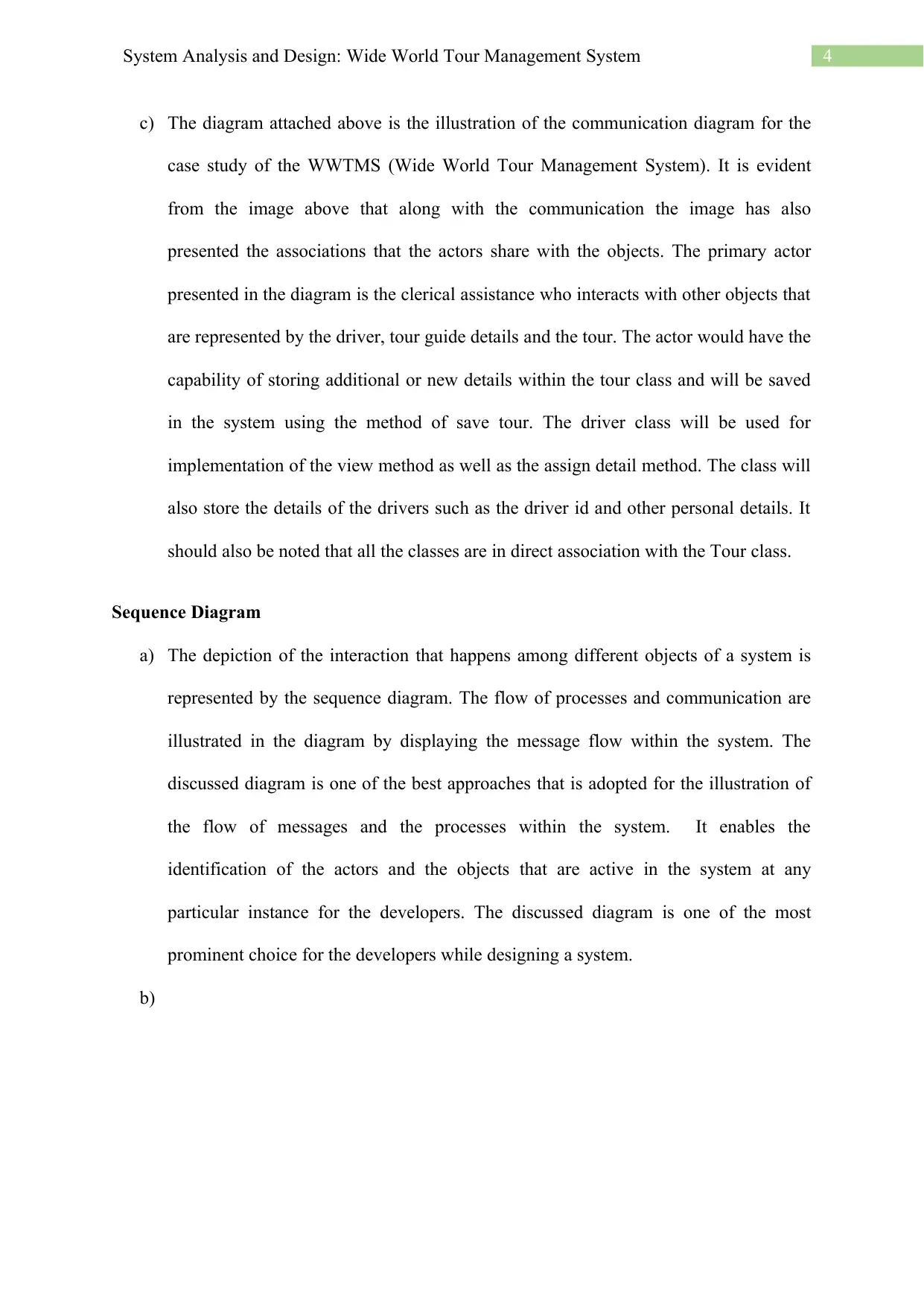
4System Analysis and Design: Wide World Tour Management System
c) The diagram attached above is the illustration of the communication diagram for the
case study of the WWTMS (Wide World Tour Management System). It is evident
from the image above that along with the communication the image has also
presented the associations that the actors share with the objects. The primary actor
presented in the diagram is the clerical assistance who interacts with other objects that
are represented by the driver, tour guide details and the tour. The actor would have the
capability of storing additional or new details within the tour class and will be saved
in the system using the method of save tour. The driver class will be used for
implementation of the view method as well as the assign detail method. The class will
also store the details of the drivers such as the driver id and other personal details. It
should also be noted that all the classes are in direct association with the Tour class.
Sequence Diagram
a) The depiction of the interaction that happens among different objects of a system is
represented by the sequence diagram. The flow of processes and communication are
illustrated in the diagram by displaying the message flow within the system. The
discussed diagram is one of the best approaches that is adopted for the illustration of
the flow of messages and the processes within the system. It enables the
identification of the actors and the objects that are active in the system at any
particular instance for the developers. The discussed diagram is one of the most
prominent choice for the developers while designing a system.
b)
c) The diagram attached above is the illustration of the communication diagram for the
case study of the WWTMS (Wide World Tour Management System). It is evident
from the image above that along with the communication the image has also
presented the associations that the actors share with the objects. The primary actor
presented in the diagram is the clerical assistance who interacts with other objects that
are represented by the driver, tour guide details and the tour. The actor would have the
capability of storing additional or new details within the tour class and will be saved
in the system using the method of save tour. The driver class will be used for
implementation of the view method as well as the assign detail method. The class will
also store the details of the drivers such as the driver id and other personal details. It
should also be noted that all the classes are in direct association with the Tour class.
Sequence Diagram
a) The depiction of the interaction that happens among different objects of a system is
represented by the sequence diagram. The flow of processes and communication are
illustrated in the diagram by displaying the message flow within the system. The
discussed diagram is one of the best approaches that is adopted for the illustration of
the flow of messages and the processes within the system. It enables the
identification of the actors and the objects that are active in the system at any
particular instance for the developers. The discussed diagram is one of the most
prominent choice for the developers while designing a system.
b)
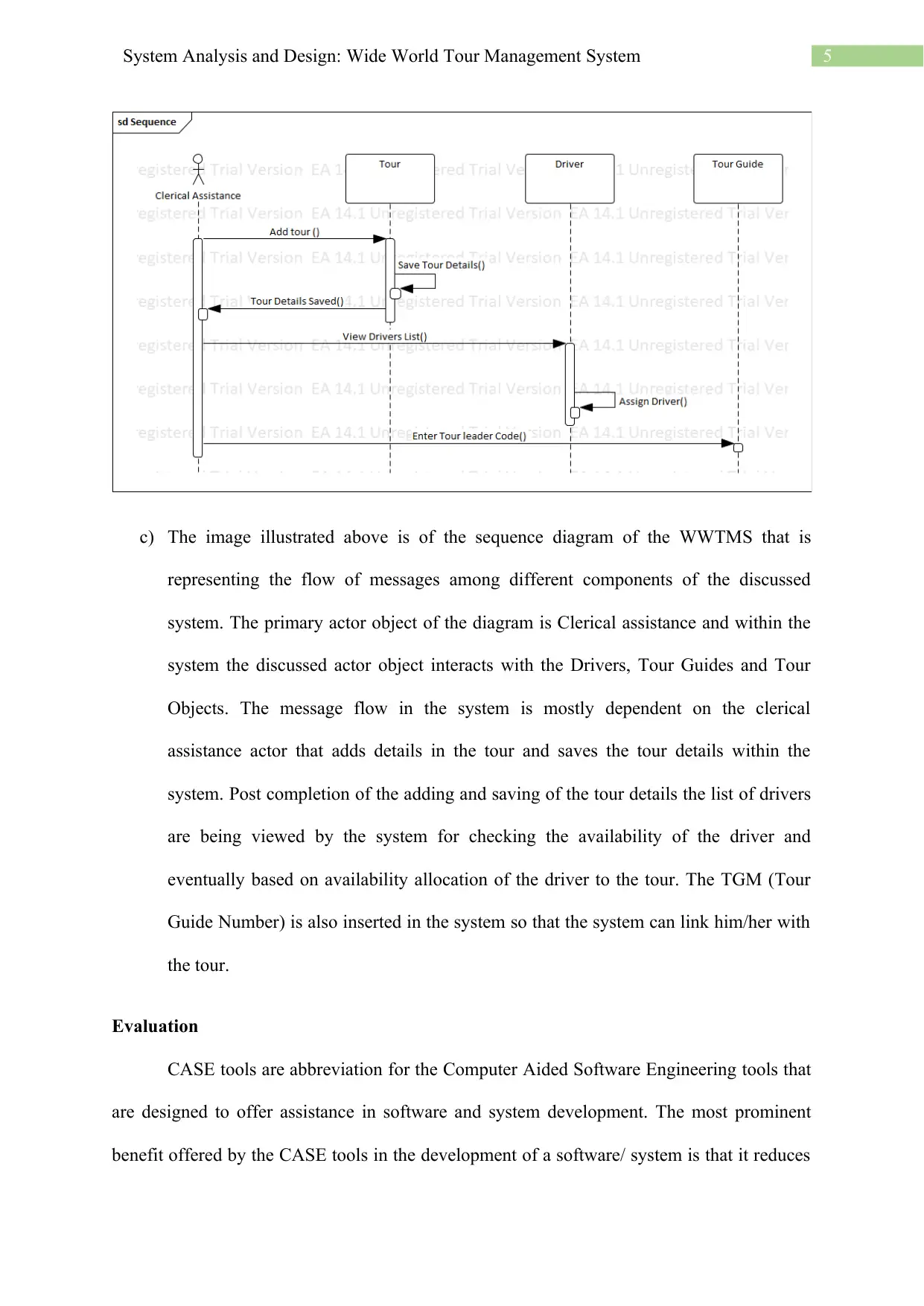
5System Analysis and Design: Wide World Tour Management System
c) The image illustrated above is of the sequence diagram of the WWTMS that is
representing the flow of messages among different components of the discussed
system. The primary actor object of the diagram is Clerical assistance and within the
system the discussed actor object interacts with the Drivers, Tour Guides and Tour
Objects. The message flow in the system is mostly dependent on the clerical
assistance actor that adds details in the tour and saves the tour details within the
system. Post completion of the adding and saving of the tour details the list of drivers
are being viewed by the system for checking the availability of the driver and
eventually based on availability allocation of the driver to the tour. The TGM (Tour
Guide Number) is also inserted in the system so that the system can link him/her with
the tour.
Evaluation
CASE tools are abbreviation for the Computer Aided Software Engineering tools that
are designed to offer assistance in software and system development. The most prominent
benefit offered by the CASE tools in the development of a software/ system is that it reduces
c) The image illustrated above is of the sequence diagram of the WWTMS that is
representing the flow of messages among different components of the discussed
system. The primary actor object of the diagram is Clerical assistance and within the
system the discussed actor object interacts with the Drivers, Tour Guides and Tour
Objects. The message flow in the system is mostly dependent on the clerical
assistance actor that adds details in the tour and saves the tour details within the
system. Post completion of the adding and saving of the tour details the list of drivers
are being viewed by the system for checking the availability of the driver and
eventually based on availability allocation of the driver to the tour. The TGM (Tour
Guide Number) is also inserted in the system so that the system can link him/her with
the tour.
Evaluation
CASE tools are abbreviation for the Computer Aided Software Engineering tools that
are designed to offer assistance in software and system development. The most prominent
benefit offered by the CASE tools in the development of a software/ system is that it reduces
⊘ This is a preview!⊘
Do you want full access?
Subscribe today to unlock all pages.

Trusted by 1+ million students worldwide
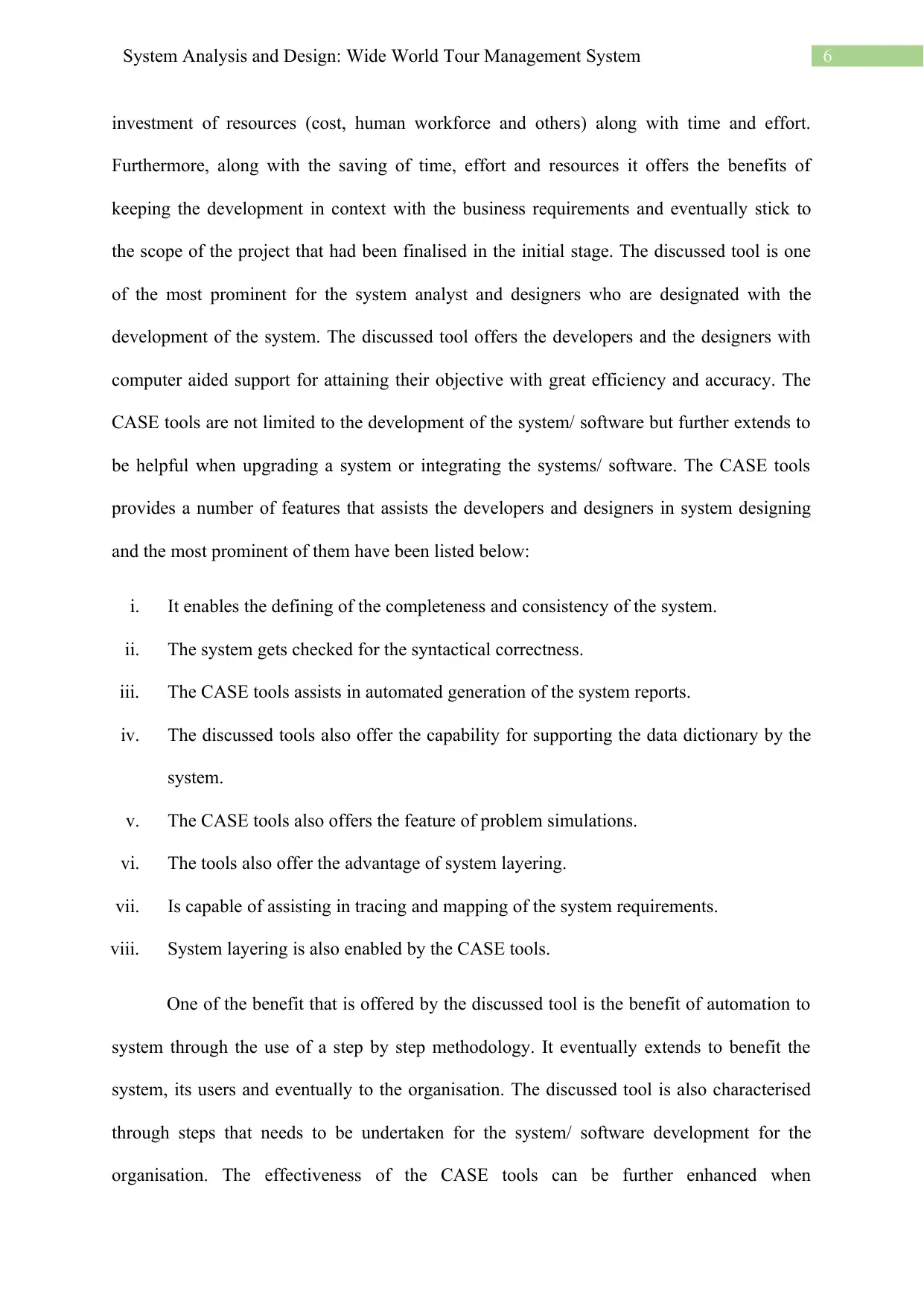
6System Analysis and Design: Wide World Tour Management System
investment of resources (cost, human workforce and others) along with time and effort.
Furthermore, along with the saving of time, effort and resources it offers the benefits of
keeping the development in context with the business requirements and eventually stick to
the scope of the project that had been finalised in the initial stage. The discussed tool is one
of the most prominent for the system analyst and designers who are designated with the
development of the system. The discussed tool offers the developers and the designers with
computer aided support for attaining their objective with great efficiency and accuracy. The
CASE tools are not limited to the development of the system/ software but further extends to
be helpful when upgrading a system or integrating the systems/ software. The CASE tools
provides a number of features that assists the developers and designers in system designing
and the most prominent of them have been listed below:
i. It enables the defining of the completeness and consistency of the system.
ii. The system gets checked for the syntactical correctness.
iii. The CASE tools assists in automated generation of the system reports.
iv. The discussed tools also offer the capability for supporting the data dictionary by the
system.
v. The CASE tools also offers the feature of problem simulations.
vi. The tools also offer the advantage of system layering.
vii. Is capable of assisting in tracing and mapping of the system requirements.
viii. System layering is also enabled by the CASE tools.
One of the benefit that is offered by the discussed tool is the benefit of automation to
system through the use of a step by step methodology. It eventually extends to benefit the
system, its users and eventually to the organisation. The discussed tool is also characterised
through steps that needs to be undertaken for the system/ software development for the
organisation. The effectiveness of the CASE tools can be further enhanced when
investment of resources (cost, human workforce and others) along with time and effort.
Furthermore, along with the saving of time, effort and resources it offers the benefits of
keeping the development in context with the business requirements and eventually stick to
the scope of the project that had been finalised in the initial stage. The discussed tool is one
of the most prominent for the system analyst and designers who are designated with the
development of the system. The discussed tool offers the developers and the designers with
computer aided support for attaining their objective with great efficiency and accuracy. The
CASE tools are not limited to the development of the system/ software but further extends to
be helpful when upgrading a system or integrating the systems/ software. The CASE tools
provides a number of features that assists the developers and designers in system designing
and the most prominent of them have been listed below:
i. It enables the defining of the completeness and consistency of the system.
ii. The system gets checked for the syntactical correctness.
iii. The CASE tools assists in automated generation of the system reports.
iv. The discussed tools also offer the capability for supporting the data dictionary by the
system.
v. The CASE tools also offers the feature of problem simulations.
vi. The tools also offer the advantage of system layering.
vii. Is capable of assisting in tracing and mapping of the system requirements.
viii. System layering is also enabled by the CASE tools.
One of the benefit that is offered by the discussed tool is the benefit of automation to
system through the use of a step by step methodology. It eventually extends to benefit the
system, its users and eventually to the organisation. The discussed tool is also characterised
through steps that needs to be undertaken for the system/ software development for the
organisation. The effectiveness of the CASE tools can be further enhanced when
Paraphrase This Document
Need a fresh take? Get an instant paraphrase of this document with our AI Paraphraser
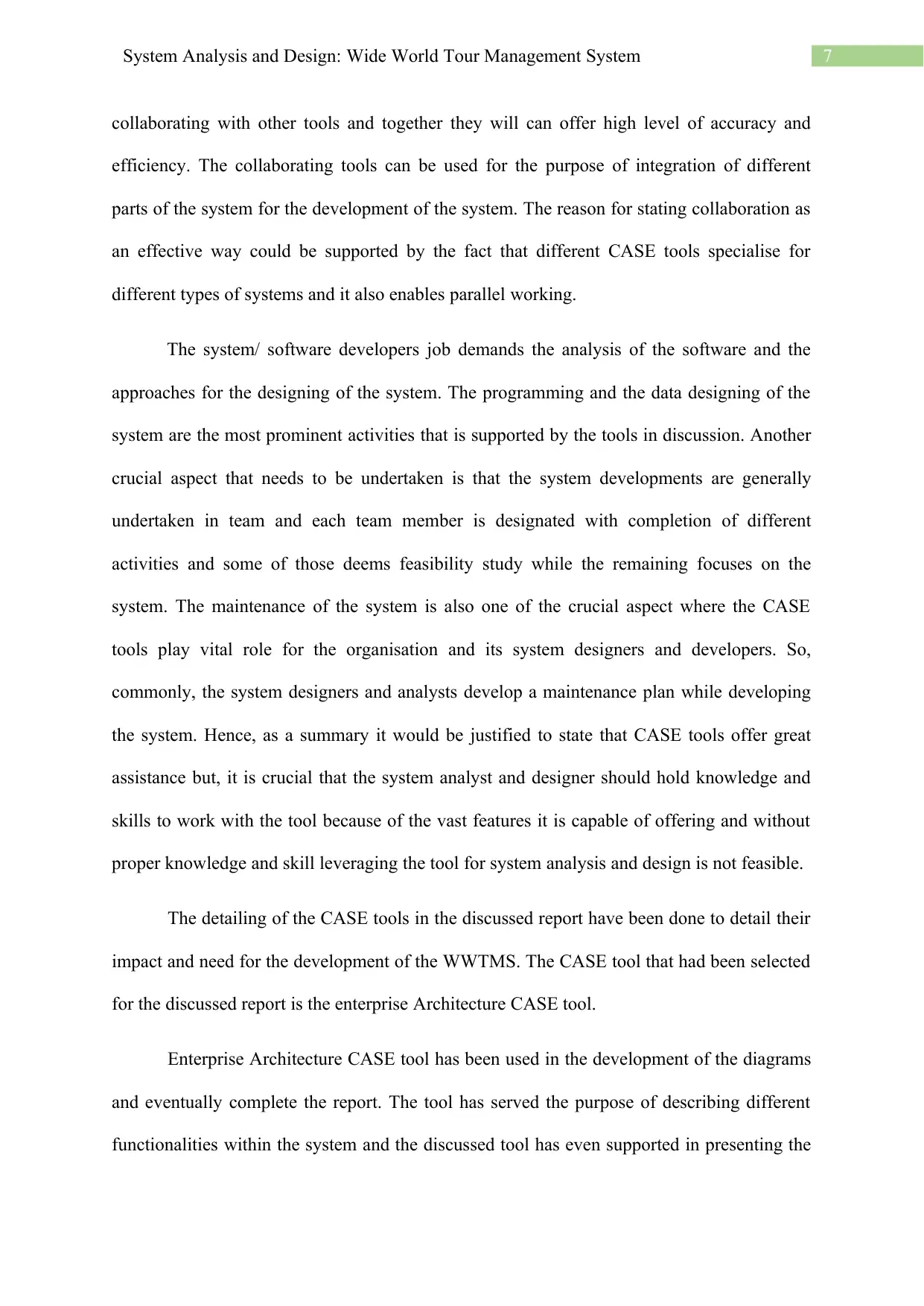
7System Analysis and Design: Wide World Tour Management System
collaborating with other tools and together they will can offer high level of accuracy and
efficiency. The collaborating tools can be used for the purpose of integration of different
parts of the system for the development of the system. The reason for stating collaboration as
an effective way could be supported by the fact that different CASE tools specialise for
different types of systems and it also enables parallel working.
The system/ software developers job demands the analysis of the software and the
approaches for the designing of the system. The programming and the data designing of the
system are the most prominent activities that is supported by the tools in discussion. Another
crucial aspect that needs to be undertaken is that the system developments are generally
undertaken in team and each team member is designated with completion of different
activities and some of those deems feasibility study while the remaining focuses on the
system. The maintenance of the system is also one of the crucial aspect where the CASE
tools play vital role for the organisation and its system designers and developers. So,
commonly, the system designers and analysts develop a maintenance plan while developing
the system. Hence, as a summary it would be justified to state that CASE tools offer great
assistance but, it is crucial that the system analyst and designer should hold knowledge and
skills to work with the tool because of the vast features it is capable of offering and without
proper knowledge and skill leveraging the tool for system analysis and design is not feasible.
The detailing of the CASE tools in the discussed report have been done to detail their
impact and need for the development of the WWTMS. The CASE tool that had been selected
for the discussed report is the enterprise Architecture CASE tool.
Enterprise Architecture CASE tool has been used in the development of the diagrams
and eventually complete the report. The tool has served the purpose of describing different
functionalities within the system and the discussed tool has even supported in presenting the
collaborating with other tools and together they will can offer high level of accuracy and
efficiency. The collaborating tools can be used for the purpose of integration of different
parts of the system for the development of the system. The reason for stating collaboration as
an effective way could be supported by the fact that different CASE tools specialise for
different types of systems and it also enables parallel working.
The system/ software developers job demands the analysis of the software and the
approaches for the designing of the system. The programming and the data designing of the
system are the most prominent activities that is supported by the tools in discussion. Another
crucial aspect that needs to be undertaken is that the system developments are generally
undertaken in team and each team member is designated with completion of different
activities and some of those deems feasibility study while the remaining focuses on the
system. The maintenance of the system is also one of the crucial aspect where the CASE
tools play vital role for the organisation and its system designers and developers. So,
commonly, the system designers and analysts develop a maintenance plan while developing
the system. Hence, as a summary it would be justified to state that CASE tools offer great
assistance but, it is crucial that the system analyst and designer should hold knowledge and
skills to work with the tool because of the vast features it is capable of offering and without
proper knowledge and skill leveraging the tool for system analysis and design is not feasible.
The detailing of the CASE tools in the discussed report have been done to detail their
impact and need for the development of the WWTMS. The CASE tool that had been selected
for the discussed report is the enterprise Architecture CASE tool.
Enterprise Architecture CASE tool has been used in the development of the diagrams
and eventually complete the report. The tool has served the purpose of describing different
functionalities within the system and the discussed tool has even supported in presenting the

8System Analysis and Design: Wide World Tour Management System
description in form of illustrations that will be greatly beneficial for the developers and the
designers as they can visualise the system and act accordingly. The visualising of the system
will enable them to identify errors and improve the system based on their knowledge,
business requirement and with little creative thinking.
description in form of illustrations that will be greatly beneficial for the developers and the
designers as they can visualise the system and act accordingly. The visualising of the system
will enable them to identify errors and improve the system based on their knowledge,
business requirement and with little creative thinking.
⊘ This is a preview!⊘
Do you want full access?
Subscribe today to unlock all pages.

Trusted by 1+ million students worldwide
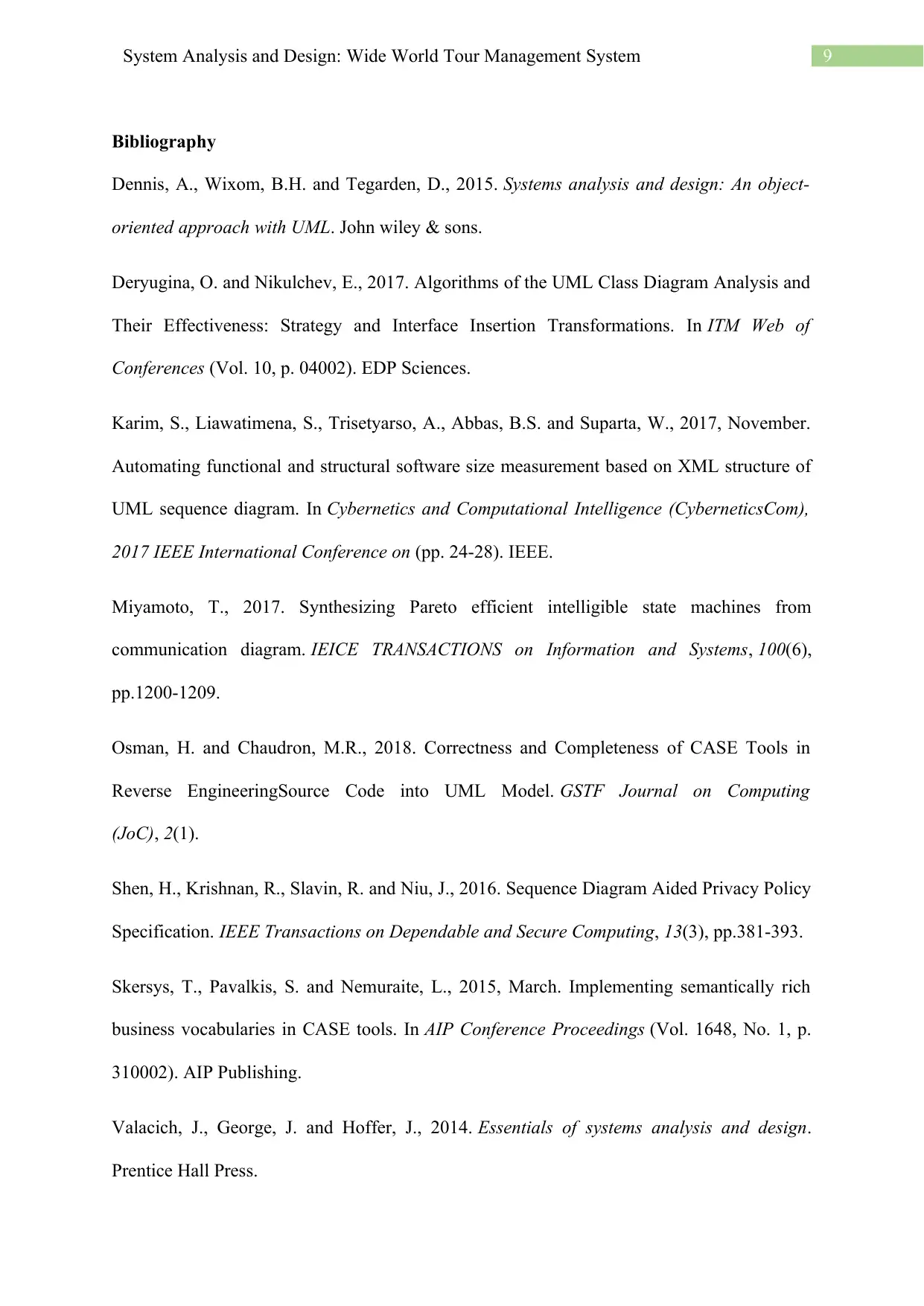
9System Analysis and Design: Wide World Tour Management System
Bibliography
Dennis, A., Wixom, B.H. and Tegarden, D., 2015. Systems analysis and design: An object-
oriented approach with UML. John wiley & sons.
Deryugina, O. and Nikulchev, E., 2017. Algorithms of the UML Class Diagram Analysis and
Their Effectiveness: Strategy and Interface Insertion Transformations. In ITM Web of
Conferences (Vol. 10, p. 04002). EDP Sciences.
Karim, S., Liawatimena, S., Trisetyarso, A., Abbas, B.S. and Suparta, W., 2017, November.
Automating functional and structural software size measurement based on XML structure of
UML sequence diagram. In Cybernetics and Computational Intelligence (CyberneticsCom),
2017 IEEE International Conference on (pp. 24-28). IEEE.
Miyamoto, T., 2017. Synthesizing Pareto efficient intelligible state machines from
communication diagram. IEICE TRANSACTIONS on Information and Systems, 100(6),
pp.1200-1209.
Osman, H. and Chaudron, M.R., 2018. Correctness and Completeness of CASE Tools in
Reverse EngineeringSource Code into UML Model. GSTF Journal on Computing
(JoC), 2(1).
Shen, H., Krishnan, R., Slavin, R. and Niu, J., 2016. Sequence Diagram Aided Privacy Policy
Specification. IEEE Transactions on Dependable and Secure Computing, 13(3), pp.381-393.
Skersys, T., Pavalkis, S. and Nemuraite, L., 2015, March. Implementing semantically rich
business vocabularies in CASE tools. In AIP Conference Proceedings (Vol. 1648, No. 1, p.
310002). AIP Publishing.
Valacich, J., George, J. and Hoffer, J., 2014. Essentials of systems analysis and design.
Prentice Hall Press.
Bibliography
Dennis, A., Wixom, B.H. and Tegarden, D., 2015. Systems analysis and design: An object-
oriented approach with UML. John wiley & sons.
Deryugina, O. and Nikulchev, E., 2017. Algorithms of the UML Class Diagram Analysis and
Their Effectiveness: Strategy and Interface Insertion Transformations. In ITM Web of
Conferences (Vol. 10, p. 04002). EDP Sciences.
Karim, S., Liawatimena, S., Trisetyarso, A., Abbas, B.S. and Suparta, W., 2017, November.
Automating functional and structural software size measurement based on XML structure of
UML sequence diagram. In Cybernetics and Computational Intelligence (CyberneticsCom),
2017 IEEE International Conference on (pp. 24-28). IEEE.
Miyamoto, T., 2017. Synthesizing Pareto efficient intelligible state machines from
communication diagram. IEICE TRANSACTIONS on Information and Systems, 100(6),
pp.1200-1209.
Osman, H. and Chaudron, M.R., 2018. Correctness and Completeness of CASE Tools in
Reverse EngineeringSource Code into UML Model. GSTF Journal on Computing
(JoC), 2(1).
Shen, H., Krishnan, R., Slavin, R. and Niu, J., 2016. Sequence Diagram Aided Privacy Policy
Specification. IEEE Transactions on Dependable and Secure Computing, 13(3), pp.381-393.
Skersys, T., Pavalkis, S. and Nemuraite, L., 2015, March. Implementing semantically rich
business vocabularies in CASE tools. In AIP Conference Proceedings (Vol. 1648, No. 1, p.
310002). AIP Publishing.
Valacich, J., George, J. and Hoffer, J., 2014. Essentials of systems analysis and design.
Prentice Hall Press.
1 out of 10
Related Documents
Your All-in-One AI-Powered Toolkit for Academic Success.
+13062052269
info@desklib.com
Available 24*7 on WhatsApp / Email
![[object Object]](/_next/static/media/star-bottom.7253800d.svg)
Unlock your academic potential
Copyright © 2020–2025 A2Z Services. All Rights Reserved. Developed and managed by ZUCOL.





